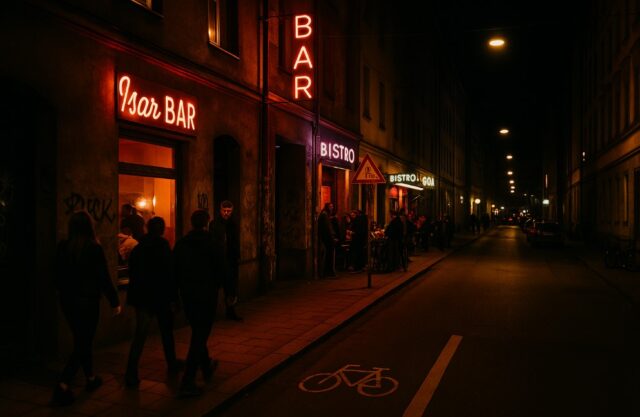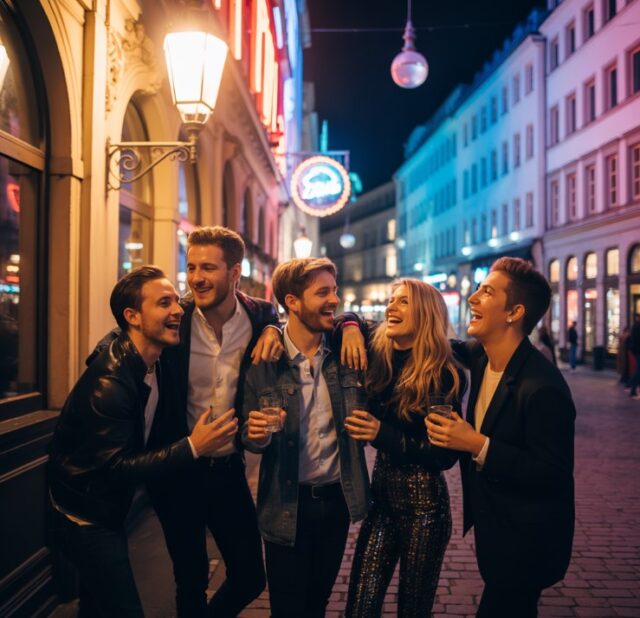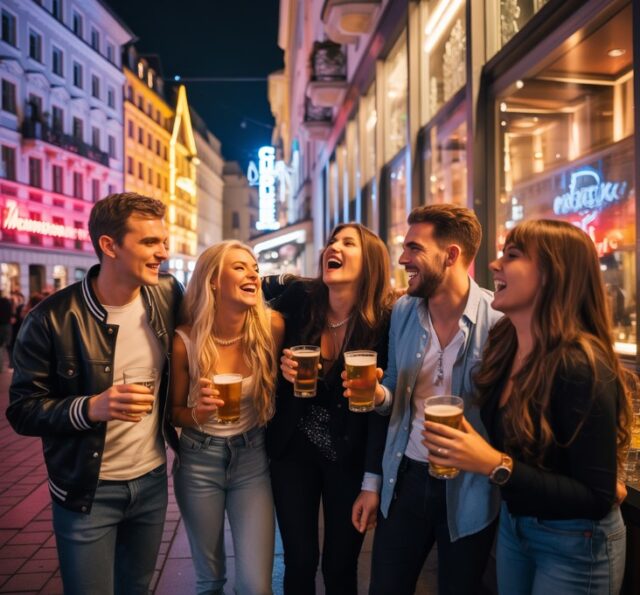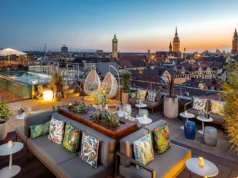
Munich’s nightlife is not the loudest in Europe, nor the cheapest, nor the wildest in the way Berlin is. The truth is simpler and more concrete: the real energy in Munich lives in a tight network of streets and clubs where locals mix with internationals, where the music is curated more than chaotic, and where each neighborhood has its own rhythm.
If someone lands in the city for just one weekend and wants the kind of night that Munich residents actually talk about, the places that matter are Glockenbachviertel, Schwabing, Maxvorstadt, and the industrial zones around Ostbahnhof. Everything else is secondary.
What makes Munich’s nightlife interesting is not its size but its structure. The best venues cluster around walkable streets where bars and clubs sit close enough that people drift from one place to the next without planning.
The most important rule is to skip the tourist-only bars near Marienplatz. Locals rarely stay there, and the atmosphere feels curated for travelers. The areas described below are where Munich’s nights genuinely stretch toward morning.
The Core Neighborhoods: Where the Night Starts and Ends

Glockenbachviertel: Munich’s Most Consistent Nightlife Hub
Glockenbachviertel is the district where young professionals, creatives, students, and long-time Munich residents merge into one of the city’s most reliable nightlife zones. The streets around Müllerstrasse, Hans-Sachs-Strasse, and Reichenbachstrasse stay active from early evening until long after midnight. Bars are compact, close together, and designed for long conversations, good drinks, and a bit of flirting. The energy here is friendly, high-volume, and effortlessly international.
A night usually begins in the smaller cocktail bars or wine places, then escalates toward the bigger rooms and late-night dance floors. Because of the density of venues, crowds move in waves: early drinkers fill the bars from 8 p.m. to 11 p.m., and by midnight, most people drift toward clubs near the Isar river or further south toward Sendlinger Tor.
A quick orientation table helps capture Glockenbach’s character:
| Street / Area | What Happens Here | Best For | Typical Closing Time |
| Müllerstrasse | Tight cluster of bars, mixed crowd | Bar hopping | 2–3 a.m. |
| Hans-Sachs-Strasse | Louder, more energetic | Meeting people | 3 a.m. |
| Reichenbachstrasse | Trendy cocktails, outdoor seating | Starting the evening | 1–2 a.m. |
Long-time Munich residents say Glockenbach is the safest option for anyone who wants a night with both structure and spontaneity. You can enter the district with no plan and still end up in two or three memorable spots.
Schwabing: Artistic, Vintage, and Still Full of Late-Night Surprises
Schwabing has changed over the years, becoming calmer and more residential, but it still holds pockets of nightlife worth exploring. The area around Leopoldstrasse, Schellingstrasse, and Hohenzollernstrasse keeps a classic Munich atmosphere: café-style bars that transition into louder dance rooms as the night thickens.
Schwabing tends to appeal to an older crowd compared to Glockenbach: late-20s to late-30s, with many locals who prefer deeper conversations, jazz bars, and lounges with curated cocktails. If the plan is to move slowly, enjoy good drinks, and then step into a club after midnight, Schwabing delivers.
The district also has a different kind of social energy. People here are more relaxed, less hurried, and conversations stretch out longer. Anyone who prefers a smoother beginning to the night usually starts here before heading to Maxvorstadt or Ostbahnhof for heavier clubbing.
Maxvorstadt: Students, DJs, and the City’s Most Productive Bar Hopping Zone
Maxvorstadt is Munich’s university district, filled with students, artists, exchange students, and young professionals. The crowd is lively, the drinks are more affordable than in other neighborhoods, and streets like Türkenstrasse and Barerstrasse stay busy every night of the week.
Bars in Maxvorstadt specialize in atmosphere rather than exclusivity. The music is louder, the dress code more relaxed, and the overall feel more chaotic in a fun way. Because students dominate the area, you can find people in the streets until very late, especially near the university buildings.
A table helps visualize the nightlife rhythm of Maxvorstadt:
| Area | Vibe | Music | Crowd | Why Go |
| Türkenstrasse | Young, busy | House, pop | Students, travelers | Constant energy |
| Barerstrasse | Mixed ages | Eclectic | Internationals | Easy meeting spots |
| University blocks | Outdoor drinking | Spontaneous | Very young | Cheap pre-gaming |
If someone wants a night where the atmosphere feels alive from every corner, Maxvorstadt is the most reliable district.
Ostbahnhof and the Industrial Zone: Munich’s Real Clubbing Core
Away from the residential districts lies Munich’s most serious nightlife cluster. The industrial spaces around Ostbahnhof and Kultfabrik have hosted electronic music events for decades. Some of the city’s best DJs perform here, along with international names across techno, house, and experimental electronic styles.
This zone has a very different personality. It is less polished, darker, louder, and more intense. People who come here expect long nights that stretch past sunrise. Drinks are straightforward, crowds are diverse, and nobody cares about dress codes as long as you respect the venue.
Two important notes define this district:
- The clubs operate independently, so queues vary widely.
- Music selection is more important than aesthetics.
Anyone who wants to experience Munich’s true club culture needs at least one night in this zone.
The Clubs That Define Munich’s Nightlife
Below are some of the venues that shape the real energy of the city. The goal is not to list every club in Munich but to highlight the ones local nightlifers consistently return to.
Harry Klein
One of Munich’s essential techno institutions. Harry Klein is known for immersive visuals, clean sound, and booking both established and rising electronic artists. It attracts a mixed crowd, from students to long-time clubbers, and the atmosphere is open, expressive, and unpretentious.
People come here for the music before anything else. Nights often start slowly and build into deep, hypnotic sets that last until morning.
P1
P1 is the opposite end of Munich’s nightlife spectrum. It is high-end, selective, and known for drawing celebrities, athletes, and wealthy visitors. Drinks are expensive, the dress code is strict, and the interior feels polished and curated. Many Munich locals roll their eyes at P1, but some truly enjoy it for special occasions. It represents the luxury side of the city that still holds cultural weight.
Bar Romi, Call Me Drella & the Hybrid Bars
The bars between Glockenbach and Sendlinger Tor represent a hybrid format that Munich has perfected: half-bar, half-club, with the flexibility to shift from cocktails to full dancing depending on the night. These venues matter because they keep the night flowing and create a smooth path between calmer districts and more intense dance floors.
Streets That Carry the City’s After-Hours Pulse
Some of Munich’s nightlife does not revolve around specific clubs but around the social atmosphere of certain streets. These streets combine bars, food spots, late-night bakeries, and easy transport access.
Sonnenstrasse & Sendlinger Tor
Sonnenstrasse is one of Munich’s busiest nighttime arteries. People pass through it constantly because it sits between multiple nightlife districts. It is not the prettiest part of Munich, but its energy never truly dies. When clubs close, many crowds gather here to regroup, grab food, or decide where to go next.
The Isar River Banks
The river becomes a nighttime meeting point during summer. People sit along the water with drinks, music, and small groups of friends. While not technically a “nightlife street,” the river provides a calm contrast to the loud clubs and gives nights a slower, more atmospheric ending.
Crowd Dynamics: Who Goes Where?
Different parts of the city attract different kinds of people. Understanding the pattern helps plan the night with more precision.
| District | Typical Crowd | Price Level | Social Energy |
| Glockenbachviertel | 25–40, mixed locals | Medium | High, warm, easy to meet people |
| Schwabing | 28–45, creatives & professionals | Medium-high | Smooth, stylish |
| Maxvorstadt | 18–30, students | Low-medium | Loud, social, animated |
| Ostbahnhof | Mixed, club-focused | Varies | Intense nightlife |
| P1 zone | High-end visitors | High | Exclusive |
These differences shape the rhythm of a Munich night. People often start in Schwabing or Glockenbach, then migrate toward Maxvorstadt or Ostbahnhof, depending on their energy level.
Social Connections and After-Hours Options
Munich’s nightlife offers different types of social environments: clubs, bars, cafés, and late-night lounges.
Some travelers also look for companionship options that feel safe, discreet, and local. Within that context, services like Louisa Escort occasionally appear in nightlife conversations, especially among visitors who want curated companionship or someone who knows the city’s districts well.
The key is to approach everything responsibly and with respect for local laws and norms.
Final Thoughts: Where the Real Energy Lives

Munich’s nightlife is defined by its districts, not by one iconic club. The real energy spreads through Glockenbach’s tight bar clusters, the university blocks of Maxvorstadt, the artistic lounges of Schwabing, and the industrial heartbeat near Ostbahnhof. Each neighborhood frames a different kind of night, and together they create a city where you can drift from quiet drinks to sunrise techno without ever feeling lost.










